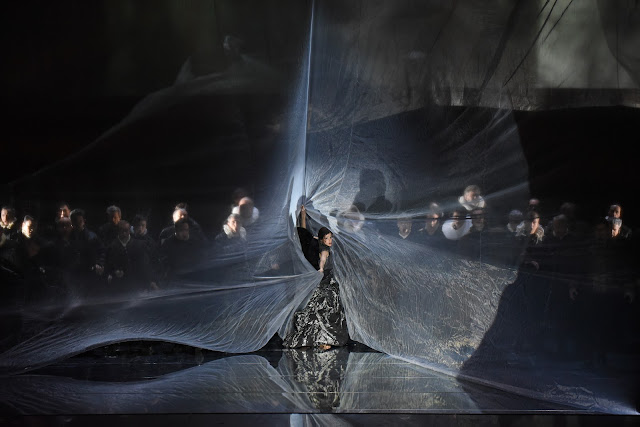Perhaps the most surprising thing about Hans Neuenfels’s
Berliner Staatsoper staging of Ariadne
auf Naxos is its apparent pervading sense of gentleness,
if that’s the word, even at times a sort of neutrality.
Katrin Lea Tag’s set is essentially a white half-box, with
moveable walls and backdrops (one in the Prologue features a cash dispenser).
The main feeling is one of pared-down abstraction: there’s no sense of being backstage
in the Prologue, not much feeling of being on
stage in the Opera, where Ariadne weeps on a chaise longue surrounded by the
antique rubble that tumbles down from the back at the end of the Prologue.
Around her, Harlekin and his troupe try to rebuild something
from this. Ariadne’s mistaking Bacchus for Hermes is spelled out when the latter arrives in the form of a
golden statuette as part of a strange, macabre procession. Bacchus himself
stage-manages his appearance, with Najade, Dryade and Echo becoming his
assistants.
 The three attendants begin the act like the Norns at the start of Götterdämmerung, the Composer—who
reappears at various points—having furnished them with a ball of three threads,
which they then use to lift Ariadne, puppet-like, from her torpor. During her
main arias, meanwhile, an actual puppet artist, dressed in black with ‘Das
Schicksal’ on his back, weaves around her with a bare head on each hand—Ariadne
and Theseus, one might assume.
The three attendants begin the act like the Norns at the start of Götterdämmerung, the Composer—who
reappears at various points—having furnished them with a ball of three threads,
which they then use to lift Ariadne, puppet-like, from her torpor. During her
main arias, meanwhile, an actual puppet artist, dressed in black with ‘Das
Schicksal’ on his back, weaves around her with a bare head on each hand—Ariadne
and Theseus, one might assume.
Ariadne has one of
those Strauss-Hofmannsthal happy endings that is only half-convincing:
Hofmannsthal talks of transformation, but Strauss doesn’t allow his music in
this work, or even less in Die Frau ohne
Schatten (which follows both in their collaboration and in the Staatsoper’s 16/17 Spielplan), to jettison the pain of what’s come before. Happiness, the
implication seems to be, is contingent on living with and gradually processing that memory.
Here, though, Neuenfels denies us that: Bacchus does
his best to persuade Ariadne, his performance, it struck me, slightly reminiscent of the
unsuccessful mating dance of some rainforest bird. And he’s about as troubled by
his failure, too: he has given up by the close of the duet, which he sings with generalised anguish from
the orchestral pit. Ariadne, in the end, prefers to die. As the synopsis in the
programme puts it: ‘She thus fulfils the words of the Composer: “She wants to
die! No, she really does die.”’
 Out goes the lesson that, according to Hofmannsthal, Ariadne
should learn from from Zerbinetta, which maybe explains why their opposing
attitudes are presented in bald opposition during the latter’s aria, where each
inscribes the essence of their Liebesphilosophie
in chalk on one side of the stage.
Out goes the lesson that, according to Hofmannsthal, Ariadne
should learn from from Zerbinetta, which maybe explains why their opposing
attitudes are presented in bald opposition during the latter’s aria, where each
inscribes the essence of their Liebesphilosophie
in chalk on one side of the stage. It's a bold ending, and one that's perhaps also surprising given that Zerbinetta is presented
with rare sympathy, smartly-dressed, grown-up and unusually sensible, and sung
with real spark here, if not quite an ideal level of pinpoint coloratura, by
Elena Sanch-Pereg.
It's a bold ending, and one that's perhaps also surprising given that Zerbinetta is presented
with rare sympathy, smartly-dressed, grown-up and unusually sensible, and sung
with real spark here, if not quite an ideal level of pinpoint coloratura, by
Elena Sanch-Pereg.
You’d maybe expect the production to undercut her message,
but she’s allowed to get it across clearly; and rarely have I seen the
burgeoning feelings between her and the Composer—the ardent, youthful and
soprano-ish Katharina Kammerloher—in the Prologue presented more touchingly,
without any hint of caricature.
There was something especially touching, too,
about Kammerloher’s interactions with the excellent Music Master of Arttu
Kataja, whose own youth suggested perhaps more sympathy than usual with his
charge’s dilemma.
In fact, the comedy was underplayed throughout, not least by
the strange Haushofmeister(in) of Elisabeth Trissenaar, about as Viennese as
the staging, and hardly less abstract in her deliberately pulled-about delivery—as a character, she seemed situated somewhere
between circus ringmaster and cabaret MC. The excellent quartet around Gyula
Orendt’s touching Harlekin kept clowning refreshingly to a minimum, a strap-on
dildo each at the end of the Prologue notwithstanding.
Such an effect, though, was undoubtedly hampered by Anna
Samuil’s bold-as-brass Ariadne. Unstinting on the vibrato and the convoluted
German, she sang the notes but offered little sense of trying to explore this
most complex of roles, ploughing through her arias and failing to offer
something to match the delicately prepared cushion of sound Kim proffered her her ‘Gibt es kein hinüber’ (below, by way of totally unfair comparison, is
Gundula Janowitz showing how this can be done, in the live recording I picked
as top choice when I did a Gramophone Collection on the opera a couple of years ago)
The production rather underlines the bluster to which any
Bacchus is prone, but Roberto Saccà nonetheless sang with admirable security
and emotional grandeur—or was it here, in Neuenfels's eyes, mere grandstanding?
Finally, a mention of the playing of the Staatskapelle, a
marvel of eloquence and delicacy. And what a pleasure to here this score in a
theatre the size of the Schillertheater, a couple of hundred seats smaller than
the Stuttgart Staatstheater for which the work was originally conceived—in its first 1912 version at least.











